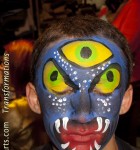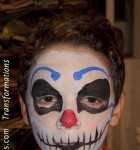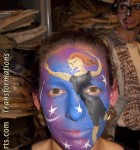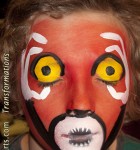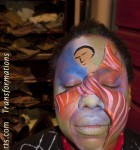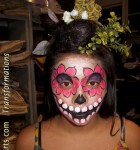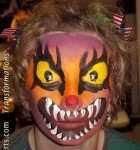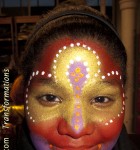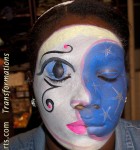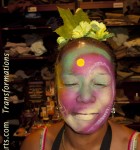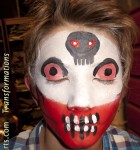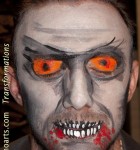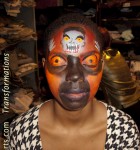Follow-up a StoryFaces Assembly Program with Classroom Workshops
Christopher’s surprising performance allows him to introduce students to complex educational concepts in an entertaining way in follow-up workshops for grade levels 2 – 12. The unique combination of visual and language arts at the heart of StoryFaces exemplifies using multiple strategies to communicate your story and demonstrates the power of art to convey social information, to retain and synthesize traditional wisdom, and to inspire — making this an ideal vehicle for workshops developing communication, visual storytelling and critical thinking skills. A variety of programs are available including mask design workshops and interdisciplinary programs combining ELA, Visual Arts and Social Studies in which students write stories and apply critical thinking to synthesize these stories into visual mask designs. Programs include:
• My Amazing StoryFace Workshop – telling a story through words and art
• Designing Symbolic Animal Masks – using symbology to bring ideas to life
• Create Your Personal Superhero – a motivational mask arts program
and two special programs for Middle and High School:
• From Masks to Modern Art – a fascinating art history program
• World Theatre Makeup – for theatre, art and fashion students
Classroom programs can be custom designed in consultation with art teachers to fit a school’s curriculum goals.
*** Professional development workshop programs also available for teachers ***
——— scroll down for full descriptions ———
———- Return to homepage: agostinoarts.com ———-
———————————————————————————————-
Workshop and Demonstration Programs include:
My Amazing StoryFace Workshop
This activity gives students their own experience in visual storytelling, as they create an original story starring themselves, first through a drawing exercise, and then as a written story meant to be told — based on one of my original stories (see The Amazing Face Video). For the drawing, students use a special Drawing Form in which they draw a cartoon picture of themselves in the story — just like the image I create in my performance. Grade Levels: In Elementary schools, grades 2 and up have been able to complete the StoryFace drawing and a simple written story in a single workshop session. In Middle and High Schools the concept of placing a portrait of yourself into an illustrated story can continue into a visual art project by incorporating other media, digital art, animation, etc. Please see the MyAmazingStoryFace_TeachersGuide for full information.
Designing Symbolic Animal Masks
This project gives students an experiential understanding of the traditional approach to art in tribal cultures as they apply critical thinking to create an animal mask design using symbols to signify the animal — in a way that even elementary students can understand. This “mask-concept” approach moves the design process away from realism and illustration, into an exploration of communicating through symbolic art and abstraction, and can be a vehicle for creating original mask designs for students with any level of art skills. Grade Levels: Grades 4 and up have been able to complete a pencil sketch design for an Animal Mask in a single session, this design can be the basis for a mask-making project in subsequent art classes. Please see TribalMaskProject_TeachersGuide for full information.
Creating Your Personal Superhero — Spirit Healing Masks
This is a unique interdisciplinary workshop program I’ve developed to get students to work on using critical thinking to synthesize and communicate information visually, through signs and symbols, in reference to the traditional role in some cultures of Spirit Masks that allow performers in rituals to represent ancestors and other powerful healing spirits that protect the people — kind of like our superhero movies. For Grade Levels 6 and up: To start, I ask each student to identify some social concern they would like to help solve — it can be anything, from the obvious ones such as “ending war” to smaller scale concerns, such as “helping stray dogs”. Next they determine what “powers” they would need as a “healing spirit” to achieve this task, and I present this via the idiom of modern superheroes —i.e., would you need to be able to fly in order to end war all around the world? The students then choose a color or graphic symbol to represent each of the powers or “attributes” their character has, and they design their Personal Superhero mask using those symbols — this step moves the design beyond an illustrative approach towards symbolism and abstraction, as the mask will communicate information purely through colors and graphics, giving students an experiential understanding of the thinking process that underlies visual arts, including modern art, and also allows any student to make a successful design regardless of their drawing skills. The process can also include a writing assignment — for example, students can write essays to accompany their designs, in which they describe the social concern, or find media links to examples of this problem, and develop a storyline for how their Personal Superhero/Healing Spirit will solve the problem. Please see SpiritHealingMask_DesignForm
———————————— PLUS ——————————————-
From Masks to Modern Art — for Middle and High Schools

Picasso/Nuba — a synthesis of a Picasso cubist portrait and a traditional design of the Southeast Nuba of Sudan
This is a unique and fascinating program giving students a vehicle for understanding the origins of Modern Art by exploring how artists such as Picasso, Matisse and Klee found inspiration in the masks, sculptures and bodyarts of cultures in Africa and Oceania as they sought to create more powerful art forms with greater social impact — what the art historians call “Primitivism in Modern Art”. After viewing African sculptures in the Trocadero Musuem, Paris in 1907, Picasso is reported to have said: “Men had made those masks and other objects for a sacred purpose…At that moment I realized that this is what painting was all about…it’s a form of magic…a way of seizing power…When I came to this realization, I knew I had found my way.”
Art changed at the beginning of the 20th century in large part because these early Modern Artists saw that in traditional cultures art was not confined to being beautiful or decorative, but rather that traditional art and artists played a vital role in maintaining the social fabric of the community — that art could have the power to communicate complex social and political ideas and help make a better world.
Christopher Agostino has also explored this seminal moment in art history through a dramatic series of fine art body paintings: Modern Primitive Art
———- Return to homepage: agostinoarts.com ———-
————————————— ADDITIONAL WORKSHOPS: ———————————————–
World Theatre Makeup — for Theatre, Art and Fashion Students
From the very beginning of human culture we have used makeup and masks to transform our appearance and create a new identity. As ancient ritual evolved into theatre, makeup remained as the way for an actor to present an identity beyond their normal self. It is especially evident in non-western theatre, such as the Chinese Opera or Japanese Kabuki in which fantastically painted faces transform performers into gods, demons, heroes and all kinds of creatures to bring myths to life. Today, traditional designs are a source for creating theatrical magic in productions like Julie Taymor’s Lion King (with makeup based on Maasai body art) and in the fantastic special effects makeup that brings aliens and superheroes to life in Hollywood movies. Christopher Agostino uses makeup and mask art from world cultures to present the story of this fundamental art from ancient origins to modern theatre in this fascinating performance/lecture illustrated by his amazing facepainting on audience volunteers.

The participants from a Transformational Makeup lecture at the U.S. Institute of
Theatre Technology Conference (USITT) in Houston, 2008.
———————————————————————————————-
Transformation Facepainting for Arts-In-Education Events
Our professional company of artists present facepainting in an educational context using styles based on World Masks, Tribal Faces, Native American Totem concepts or cultural traditions from regions around the world, such as Dia De Los Muertes or Amazon Indians. The same artists seen at the Bronx Zoo and Tri-State area events can facepaint students to create a uniquely memorable cultural experience that goes far beyond how much fun they will have. Events can be tied into assembly programs and to specific cultural regions or areas of Social Studies.
———————————————————————————————-
Makeup Artists for School Theatrical Productions
Our artists are also available to paint the faces of student performers for theatre productions and other special events. Bringing in professional artists is a thrilling experience for a young actor and a great confidence boost that makes a school production extra special.
Related articles
-
- Face Painting Gallery – Lion King school production (thestorybehindthefaces.com)







 At our annual New York events like this one, folks are familiar with the freedom and creativity we bring to each face and that encourages us to try new ideas, like this combination of a Monet color background with a dancing figure from an Andre Derain painting, as I continue to explore putting dancing figures on people’s faces. And I took the opportunity to do some “sketches” for faces I’ll be painting for a Dia De Los Muertos performance by
At our annual New York events like this one, folks are familiar with the freedom and creativity we bring to each face and that encourages us to try new ideas, like this combination of a Monet color background with a dancing figure from an Andre Derain painting, as I continue to explore putting dancing figures on people’s faces. And I took the opportunity to do some “sketches” for faces I’ll be painting for a Dia De Los Muertos performance by 